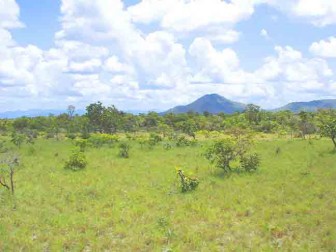Savannahs are grassland ecosystems that are characterised by small trees or trees that are widely spaced so as not create a closed canopy. The open canopy allows ample light to reach the ground to support an unbroken layer of grasses. Savannahs can be a transitional ecosystem as they separate desert or prairie from a forested area. Savannahs can be found in large areas of Australia, Africa and some places in South America, including most of Region 9, the Rupununi, in Guyana.

Savannahs usually have a higher moisture level than grasslands and receive an average rainfall of 50-150 cm annually, and the soils of savannahs are either water-logged (creating important wetland ecosystems) or completely dry.
In Guyana, the Rupununi savannahs are part of the Guiana Shield, and more specifically, the Takutu Basin and surrounding mountains including the Pakaraimas, Iwokrama, Makarapan and the Kanukus. This includes metamorphic, sedimentary and volcanic rocks that have been subject to sedimentation and erosion for over 200 million years. The geology of the area is also largely responsible for the soil type and vegetation of the area.
Although they may not look it, savannahs are home to an astounding biodiversity; wetland areas host many different plants, animals and fish and although the savannah itself looks homogeneous, it is not if you look closely at the composition of grasses and plants that make up the savannah, not to mention the diversity of animals that live there.
The grass compositions in savannahs are mixed and are drought resistant; the grasses are also have special adaptations that discourage animals from grazing on them; many of the grasses grow from the bottom up (instead from the tips up) so that growth tissues do not get damaged by grazers or destroyed by fires. Some grasses are too sharp or bitter tasting for some animals but not to others; this allows different animals to feed on different grasses ensuring that every species has something to eat. Different animals also favour and eat different parts of the grass.
Savannah trees are also well adapted for dry conditions. The leaves of the trees are usually tough and persistent. The trees have long tap roots to reach the deep water table. The tree bark will be thick to resist annual fires and some trees may have the ability to store water. Typical trees found in savannahs will be of the palm and legume variety.
The animal diversity of savannah systems across the globe differs but in general animals that frequent the savannahs are usually nomadic following the moisture and seasonal rainfall.
In Guyana’s Rupununi savannahs the animals are often similar to those found in the forest, including the Giant Anteater, Savannah Fox, Jaguar and Jaguarondi. However, bird species are very diverse and can be found in the savannah areas only: Jabiru and Wood Storks, Vermillion Flycatcher, Red Siskin, and many other seed eaters and flycatchers.
People also make savannah areas their home; in the Rupununi, the Makushi, Wapishana and Wai Wai people live in the savannahs, relying on the natural resources and surrounding forest and wetlands for their livelihood.
The Rupununi is an extraordinary natural area in southern Guyana that was well known in the 19th and early 20th centuries, when explorers, writers and naturalists inducing Sir David Attenborough, Gerald Durrell, Evelyn Waugh and Charles Waterton visited and wrote about their experiences and discoveries.
The recent upgrading of the Georgetown-Lethem road and completion of the Takutu Bridge opens new economic opportunities that may bring rapid change to the highly sensitive and unique savannah, forest, and wetland ecosystems of the Rupununi.
Rain forests are rich in biodiversity and are home to many different plants and animals. In addition, indigenous communities make their homes there. Even if you don’t live in the rain forest, humans rely on the forest for resources such as building materials (wood and lianas), medicine and fruits. Rain forests also provide essential environmental services for life on earth; they create soil as well as prevent soil erosion, produce oxygen though photosynthesis, maintain clean water systems, and are a key defence against climate change.
The Iwokrama Rain Forest is 371,000 hectares, located in the heart of Guyana. Our mission is to develop strategies for conservation and sustainable development for local people in Guyana and the world at large. We are involved in tourism, training, research and our timber is certified by the Forest Stewardship Council. Come and visit us in the rain forest or at http://www.iwokrama.org.